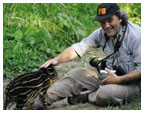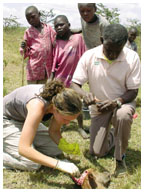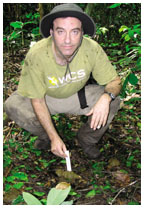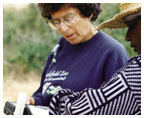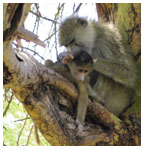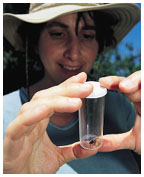June 9, 2004: Features

Professor Andrew Dobson meets a tapir during a recent Alumni College in the Peruvian Amazon. In his research, Dobson uses mathematical models to address real-life problems like disease. Below, left: Katie Hampson GS attaches a Global Positioning System collar to a domestic dog in an effort to track rabies. Below right: A man in Tanzania shows his dog wearing a G.P.S. collar.
In Tanzania, Katie Hampson GS takes a brain sample from a cow that died of rabies. (Courtesy Katie Hampson GS)
Scientist Peter Walsh measures gorilla dung in his research to estimate the abundance of gorillas and chimpanzees. This information will help monitor the effects of Ebola. (Courtesy Peter Walsh) |
Crunching
numbers, outsmarting disease
Scientists study wildlife epidemics, and safeguard human health
By Beth Livermore
A white pickup drove into camp. Eight Congolese men jumped out and ran to the nearby building. There they found Peter Walsh, a Princeton field ecologist, who had just returned from two weeks in the forest of Nouabale-Ndoki National Park. “Come see. Come see,” they shouted excitedly. “We have something for you.” Walsh straightened his tired body and walked out into the blistering heat to a flatbed swarming with flies. There lay a heap of fur and blood. It was an adult female gorilla, found dead by the roadside.
“Can we eat her?” asked one man.
“Absolutely not,” said Walsh, shivering at the thought. “Bury her as fast as you can,” he shouted. “Then wash everything with bleach.”
That was the day, in 2001, that the threat of the Ebola virus became real to Walsh, who was in the Congo to pin down how many elephants live in the region. To do this, he walked on foot across the 100-kilometer park, stopping along the way to sift through dung samples. During this trip he heard from local people that villagers were suffering from what they call “red diarrhea,” and that Ebola had left entire gorilla families dead in the jungle. This area, home to four-fifths of the world’s Lowland species, is also where Simian Immunodeficiency Virus (SIV) mutated into HIV before spreading around the world. “But the threat didn’t seem real to me until that day,” he says. Months after Walsh encountered the dead gorilla, he met other researchers at a meeting in Germany, who also worried that Ebola was killing off great apes. But no one knew how perilous the situation was.
In recent years, catastrophic epidemics have killed off huge numbers of animals, from frogs and honeybees to kangaroos and lions. Princeton scientists have been at the forefront of the effort to contain disease outbreaks through their renowned expertise in theoretical ecology, which reveals patterns found in nature through mathematics. Blending new theory and technology with old-fashioned data collection, the scientists are able not only to identify and describe disease outbreaks, but to suggest ways to limit and prevent potential epidemics. “As fantastic keystone species continue to disappear due to disease, conservationists have to accept (disease) as a major threat,” says Peter Daszak, executive director of the Consortium for Conservation Medicine, at Wildlife Trust, in New York.
Walsh, whose appointment as a visitor in Princeton’s ecology and evolutionary biology department ended this spring, was attracted to the University four years ago because of this mathematical focus. He hoped that methods from this field could help him get a grip on the impact of Ebola on primate populations in the Congo. He collated and analyzed field data that he had collected from more than 50 scientists. The results were impressive. Not only did he show that Ebola had decimated huge pockets of the primate population, he discovered that the disease was having an impact comparable to hunting, long considered the primary threat. Worse yet, if the disease continues, the entire population will be lost far sooner than previously thought, Walsh says. In fact, he predicts the great apes will be extinct from western equatorial Africa within the next 10 years unless there is dramatic intervention. Walsh’s news, published in Nature last spring, sent shock waves through the conservation community.
He then went on to build mathematical models to study where and how the Ebola virus may be spreading. His findings, which he presented last month at the Max Planck Institute, in Germany, suggest that the virus travels in somewhat predictable patterns, rather than erupting spontaneously without warning. And it appears to stop at rivers. Taken together, this information could be used to develop preventive measures for what has been thought an intractable problem. Park officials could, for example, mow areas near rivers so gorillas don’t go near them, and vaccinate animals in places where Ebola is likely to show up. Walsh is now talking to the U.S. Army about field-testing vaccines on gorillas.
Princeton has been the leader in theoretical ecology for the last 40 years, says Peter Kareiva, lead scientist at the Nature Conservancy. The highly technical field has a long and distinguished history at the University, starting with professors Robert MacArthur, in the 1960s, and Robert May in the late 1970s. Now at the helm is conservation biologist and professor Andrew Dobson, who works hard to push the field from Ivory Tower to Main Street, by emphasizing solutions for real problems, in real time, in his own work. “I tend to feel that if you only do theory, or simply do pure academic work, you’re only doing half the task,” Dobson says.
“It’s really beautiful to watch him [Dobson] work,” says Daszak, of Wildlife Trust. Dobson, Daszak says, can take a complex problem, such as the effect of avian malaria on Hawaii’s native birds, and reduce it to a set of elegant equations. Looking over Dobson’s shoulder you would see a dizzying array of cosines and arrows, which, like hieroglyphics, represent an elaborate story. Then Dobson manipulates these equations, combining real data and theory, to produce a set of possible scenarios. From these scenarios, he can produce a clear picture of historic and ongoing problems, as well as what might happen, and suggest how best to respond to an epidemic.
While Dobson’s work is mostly dedicated to preserving wildlife, it has major implications for humankind, too. Whether it is research on the vulnerability of California sea lions to pollution, or the spread of conjunctivitis among Baltimore house finches, the work of Princeton scientists is viewed as an important defense against the increasingly deadly onslaught of emerging diseases – novel pathogens, never previously seen by science, that pop up seemingly out of nowhere and spread like wildfire. “As we have more and more people connected better together, it is likely that you’ll create more opportunity” for emerging diseases to take hold, Dobson says. Most of the pathogens, including HIV, Ebola, SARS, and West Nile, are also “zoonotics,” or agents that move between animals and humans, Daszak explains, noting that we can expect to see more of them “as we continue to move into remote areas, coming into contact with pathogens that have been in animals for a millennium.” As the population grows, these diseases not only will spread faster but live longer, taking ever larger tolls. Such reasoning explains why the National Institutes of Health, dedicated to human health, fund several Dobson projects, and why the N.I.H. established the Ecology of Infectious Diseases initiative three years ago to support fundamental research on how pathogens move through populations in changing environments. And it explains why Julie Gerberding, director of the Centers for Disease Control, recently called for improved collaboration between medics and veterinarians, Daszak notes.
Last year, for example, Dobson was asked to consult on a possible rabies epidemic in Tanzania. His goal was to safeguard the lives of African wild dogs, though local people stood to benefit as well. This species of wild dogs is critically endangered, with fewer than 5,000 in the world. Experts thought the dogs had died out completely in 1991, partly due to rabies contracted from domestic dogs kept by native tribes to herd animals and protect them from wild predators. But in the last year, two packs have been spotted roaming the Serengeti Plains, with as many as 10 to 12 members in one group. Needless to say, local conservationists are ecstatic about the news. But they are also very worried, because rabies has resurfaced in the area.
Dobson and Princeton graduate student Katie Hampson traveled to Tanzania last summer to assess the magnitude of the problem in the Serengeti district. What they found, from evaluating hospital records and talking to bite victims about kichaa cha mbwa, or “craze of the dog,” is that more than 200 people had been bitten by rabid animals, resulting in at least 10 deaths in the past year. That’s “a rabies epidemic of unprecedented scale in recent Tanzanian history,” Hampson says. It is also spreading quickly. A recent case was reported 80 kilometers from the site of the first report, and researchers just started to see cases in Kenya, on Tanzania’s northern border. This is bad news for Africa. The last great rabies outbreak in 1979 spread throughout Tanzania, Kenya, and Uganda. At least 3,000 people were bitten in northern Tanzania alone.
In response, the World Health Organization (W.H.O.) conducted a mass vaccination campaign last August. Hampson calls the event “complete mayhem,” with up to 700 dogs vaccinated each day. “Entire families walk up to 10 kilometers to have their animals treated,” she says. In total, 25,000 vaccinations were administered in 10 weeks. The second annual vaccination blitz will take place this summer on the eastern side of the park. “This could be even more important,” says Hampson. For here live the Masai, a nomadic people whose dogs are most likely to intermingle with wildlife on a regular basis. And, the Masai themselves are far from health care, having to travel more than 50 kilometers on foot to the nearest hospital. So the risk of rabies to both humans and wildlife is especially great in this region.
Meanwhile, the Dobson team has continued to gather information on the spreading epidemic to help in the war against rabies. Hampson recently returned to Africa to evaluate the impact of the vaccination program, so veterinarians can target future efforts. She will study the movement patterns of domestic dogs, so authorities can control possible transmission sites. With Dobson’s help, she is building a suite of mathematical models to reveal things like the direction the disease will next travel, how many dogs will have to be vaccinated to arrest the epidemic, and how geographical features such as rivers or mountains might speed up or slow down progress of the disease. Sharing this information with W.H.O. and the Tanzanian government, the scientists hope their work will safeguard both African wild dogs and local people who cannot afford post-exposure treatment and face substantial livestock losses.
The work of Dobson and other disease ecologists ventures beyond that of a traditional epidemiologist. For in addition to working out the details of a current outbreak, including incidence and mortality rate, disease ecologists study the relationship between the hosts and their environments, in the belief that factors such as habitat disruption and temperature fluctuations frequently underpin outbreaks. “This is an exciting new approach to public health,” Daszak says. “In this research, we get to the real origin of emerging diseases – environmental changes that cause them to jump from wildlife to humans.” The ultimate goal: Find simple ways to prevent an outbreak. “Mathematical modeling is key to this process,” Daszak says.
Last year Daszak, a parasitologist, invited Dobson to collaborate on a new project, supported by a $1.4 million N.I.H. grant, that studies the Nipah virus. This previously unrecorded viral disease killed more than 100 people and thousands of pigs in Malaysia in 1998—99. Health officials believe that Nipah is carried by fruit bats and transmitted to human populations through contact with domestic animals, such as pigs and horses. The team will investigate how changes to the environment, such as deforestation, may have increased contact between the wild and domestic hosts. Then, recommendations could be made to pig farmers around the globe about how to reduce the risk of similar outbreaks among their livestock.
That would not be the first time that mathematical modeling outsmarted
an epidemic. Dengue fever, a major problem in tropical regions, now can
be preempted with help from models built on information about the mosquito
that spreads the disease. And the decision to cull some four million cattle,
pigs, and sheep to end Britain’s outbreak of foot-and-mouth disease
in 2001 was based on mathematical models that took into account everything
from farm distribution to herd size to wind patterns. So, while Dobson,
Walsh, and people like them may set out to prevent wildlife extinctions,
they ultimately may safeguard human health, through understanding how
disease works, and building tools that help suggest diseases’ next
moves. ![]()
Science writer Beth Livermore is an occasional PAW contributor.
Professor Jeanne Altmann and research assistant Serah Sayiallel use a G.P.S. to track baboons’ habitat use in Kenya. (Photos: courtesy Jeanne Altmann)
|
Baboon parenting
Professor Jeanne Altmann, of the ecology and evolutionary biology department, was richly rewarded for her primate work last year. First she was elected to the National Academy of Sciences, a major honor, largely for her groundbreaking treatise on primate mothering, based on four decades studying yellow baboons in Amboseli National Park in Kenya. Recently, Altmann added two new papers about baboon parenting to her portfolio.
In Nature last September, she reported that baboon fathers not only identify, but defend their young. This was big news to primatologists who thought baboon fathers, who are multiple maters, do not participate in parenting in any way. This finding also provides insight into the primitive origins of human paternal instinct, Altmann suggests. She came to this conclusion after identifying baboon subjects (by conducting DNA analysis of excrement samples) and documenting behavior patterns through long-term observation.
Two months later, in Science, Altmann reported that baboon mothers who
are socially integrated, or well accepted among peers, enjoy a host of
health benefits and higher offspring survival. This flies in the face
of dominance research which for years has stated that the more power primates
have over their peers, the better off they will be. “We are now
starting to investigate hormone aspects of well-being, with particular
focus on glucocorticoids,” says Altmann. For once, human research
precedes primate research. Altmann refers to the growing body of literature
that shows people with rich social networks tend to live longer, healthier
lives. ![]()
By B.L.
Assistant professor Claire Kremen examines a bee that she has just collected from a flower. (gary braasch) |
The work of bees
As a graduate student at Duke in the 1980s, Claire Kremen read a journal article about insect ecology that made her rethink the direction of her own studies. “I thought, why study these species if they’re all being destroyed?” she recalls. Instead, why not “put the same effort into slowing the destruction?” As a result, she soon volunteered to work as a field assistant in Madagascar – a decision, she says, that “changed my life forever.”
At first Kremen did basic survey work, which entailed long days in the jungle, setting and emptying butterfly traps. “You have to be really interested in what you’re doing because the privations are enormous,” she says. She would spend four days in a Zodiac inflatable boat, or seven days on foot, to arrive at her study sites, and would pitch a tent when she got there. One day, while plucking winged specimens from fermented bananas, she looked down to discover more than 100 leeches slithering inside her jacket. “It took hours to get rid of them all,” she says. But her dedication in the field paid off: Over eight years, she both identified five new butterfly species and
combined her biodiversity research with conservation skills to establish Masoala National Park, Madagascar’s largest protected area.
Now Kremen, who moved to Princeton from Stanford in 2001, focuses primarily on native bees in Northern California, where field conditions are substantially more hospitable. Still, she gets up at 6 a.m. to wander through tomato fields with a flower on a stick, attracting bees. Her goal is to develop a new way of thinking about wildlife – one that may save her study subjects in the long-term.
“Many people take the service that nature provides us for granted,” Kremen says. “However, it’s important to recognize their value and understand them, as they underpin our own survival.” To demonstrate this point she has set out to quantify the amount of labor wild bees contribute to the pollination of commercial crops. She has found that, first, wild bees pollinate no less than 10 to 20 percent of all crops in the Sacramento Valley area. Where bee communities still flourish they provide enough service to pollinate the entire crop. One free bee species is 10 times better at pollinating sunflowers than its for-hire cousin. And native bees appear to motivate honeybees, which are imported by agribusiness to do the job. In one case, working on a crop of hybrid sunflower seeds, honeybees were 10 times more efficient when mixed with native pollinators.
Kremen also has documented a drop in native bee populations, which she argues is a concern both for conservationists who worry about biodiversity, and farmers who worry about the bottom line. Consider this: Imported honey bees, used by most commercial farms to pollinate their crops, are in increasingly short supply because of disease and pesticide use. This is driving up farmers’ costs to rent them. So Kremen argues that farmers who choose to foster native bee populations are not just being good citizens. They are being smart business people.
“Claire Kremen’s work on the services provided by pollinators
stands out as the best documented example of the economic value of native
bees,” says Peter Kareiva, lead scientist for the Nature Conservancy.
Kremen is also working with the Xerces Society, which focuses on invertebrate
conservation, to provide workshops for local farmers. “There are
lots of little things that they [farmers] can do that don’t cost
a lot and will build up healthy bee populations,” she says. ![]()
By B.L.

